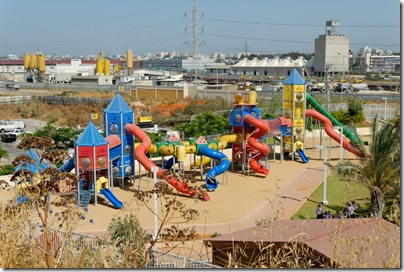This summer I was out scouting around trying to locate some sites on the Coastal Plain, including Ono, Eltekeh, and Bene-berak. Bene-berak is mentioned in Josh 19:45; 21:45; 1 Chr 9:14; Neh 11:15. The most likely location is el-Kheriyah, located about 3 miles south of the modern Israeli city of Bene-berak. I wasn’t quite sure if I had found the right spot or not. It wasn’t for lack of remains that I lacked certainty, but for an overabundance. Today it was announced that the government is going to transform the Hiriya landfill into the “Ariel Sharon Park.” While I’m not sure if I’d feel honored if a trash dump was named aft er me, I am hopeful that the $250 million project will make the ancient Israelite site accessible to tourists.
The Hiriya Landfill, located between Ramat Gan and Tel Aviv is a mountain of garbage that was used from 1952 until 1998. The government is now planning on transforming the site and the area around it into one of the largest parks in the country.The Hiriya site stretches out along 112 acres and the garbage mountain itself is elevated around 200 feet.
“The restoration project will transform Hiriya from a waste landfill into a flourishing, green park which will attract thousands of visitors each year, providing leisure and recreational opportunities as well as pleasant walks along its paths,” organizers say.
“Today is the opening shot in the building of this incredible park,” said Danny Shternberg of the Ayalon Park Government Company. “We are proud to name it for former Prime Minister Ariel Sharon, who was an enthusiastic backer of the idea, advancing the park himself.” Shternberg declined to comment on the unorthodox nature of deciding to name a park after someone who is still living.
The park will contain within it sheltered areas (such as the Menachem Begin Park), open areas, forested regions, agricultural tracts and man-made lakes and streams.
Archeological sites will also be refurbished and put on display. The ancient city of B’nei Brak, spoken of in the Passover Haggadah, lay at the site and an Arab village named Hiriya was built atop its ruins until its residents fled in 1948. Emergency plans when Israel feared an Arab victory in the 1967 Six Day War called for mass graves to be dug in the area for the expected Jewish casualties.
For more, see the Arutz-7 report.
